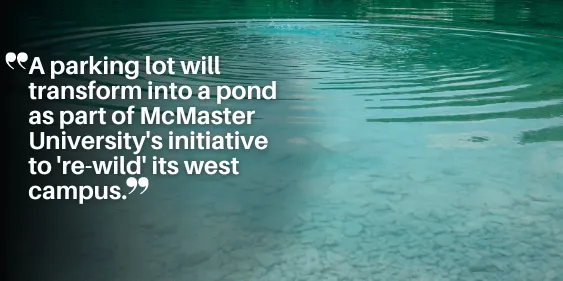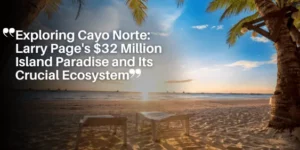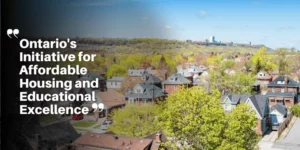A parking lot will transform into a pond as part of McMaster University’s initiative to ‘re-wild’ its west campus.

McMaster University in Hamilton, Ontario, is embarking on a transformative journey to ‘re-wild’ its west campus, turning a sprawling parking lot into a thriving natural habitat adjacent to the Cootes Paradise nature sanctuary.
This ambitious project marks a significant shift in campus planning and sustainability efforts, aiming to blend ecological restoration with educational opportunities.
The Vision for Transformation
Environmental Restoration at Its Core
Yves Bonnardeaux, senior architect at BDP Quadrangle, highlights the area’s potential for naturalization.
Situated in a flood plain and surrounded by mature trees, creeks, and trails, the west campus is primed for a return to its natural state.
Approximately 800 parking spots will gradually be reclaimed by nature, transforming the landscape into an extension of the nearby Cootes Paradise.
Central to this transformation is the formation of a new pond over the existing parking lot, symbolizing the university’s commitment to environmental stewardship.
Rewilding: A Global Trend in Environmental Restoration
The concept of rewilding, popularized in Europe, involves restoring degraded environments by removing human-built structures and allowing natural processes to regenerate the landscape.
This approach, less explored in North America until recently, mirrors successful projects in locations like the Scottish Highlands, Detroit, and Vancouver Island.
At McMaster, the rewilding process will unfold gradually, starting with efforts to reduce parking demand through alternative transportation solutions and on-campus housing developments.
Integration with Urban Infrastructure
McMaster’s rewilding initiative is not just about environmental renewal but also strategic urban planning.
Plans include constructing an above-ground parking structure to replace some surface spots, alongside expanding on-campus housing options to reduce commuter traffic.
The upcoming light rail transit (LRT) line connecting McMaster to Hamilton’s broader transit network will play a pivotal role in supporting these sustainability goals.
A Living and Learning Environment
Saher Fazilat, McMaster’s vice president of operations, envisions the west campus becoming a “living and learning lab” for students and faculty alike.
As the rewilding progresses, the area will serve as a hands-on educational resource, fostering research and engagement opportunities focused on ecological sustainability and biodiversity conservation.
Faculty and students from various disciplines, including biology, environmental science, and urban planning, will collaborate on projects aimed at monitoring wildlife, studying native plant species, and assessing the ecological impacts of the rewilding efforts.
Commitment to Sustainability and Carbon Neutrality
A Future-Oriented Master Plan
Replacing the original 2002 plan, McMaster’s new master plan reflects a paradigm shift towards integrating ecological principles into campus development.
As the rewilding initiative unfolds, McMaster University sets a precedent for sustainable campus design and environmental leadership in North America.
By prioritizing biodiversity conservation and environmental education, McMaster ensures that future generations of students and faculty will benefit from a campus environment that supports both academic excellence and ecological stewardship.
In conclusion, McMaster University’s rewilding of its west campus represents a bold step towards integrating natural ecosystems with urban infrastructure.
By transforming a parking lot into a pond and embracing ecological restoration, McMaster not only enhances biodiversity but also creates a dynamic learning environment for future generations.
As this innovative project unfolds, it promises to inspire similar initiatives across educational institutions striving for sustainability and environmental stewardship.






